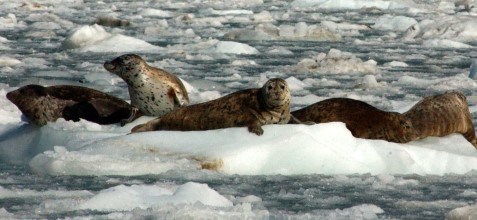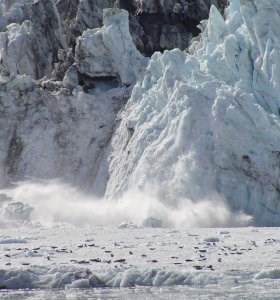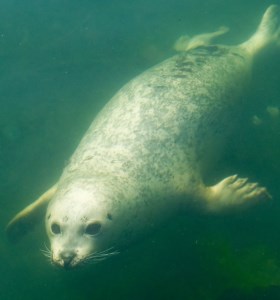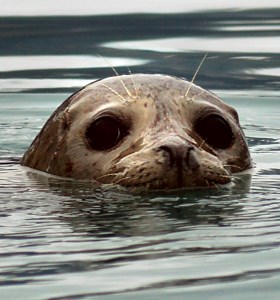Glacier Bay Harbor Seal ScienceHarbor Seal Research
NPS A visit to Glacier Bay would hardly be complete without seeing a harbor seal (Phoca vitulina), one the park's most charismatic marine mammals. These chubby pinnipeds stave off the chill of icy waters with a thick coat of blubber and are often seen lounging like giant hairy sausages on floating ice near glaciers. 
NPS At the beginning of the summer, the Johns Hopkins Inlet becomes the epicenter of seal activity. For miles in front of the glacier, seals haul out on floating ice and females give birth to 25 pound (11kg) pups. Moms nurse their pups for about a month, almost doubling the weight of their offspring during this time. As the pups grow into adulthood, their weight will approach that of a football player (180-280 pounds or 81-127kg) and they will eventually measure in at five or six feet in length. This is a sensitive time for seals, and the National Park Service has strict regulations to protect the Johns Hopkins seal nursery, restricting vessel and foot traffic for a majority of the summer. During the summer months harbor seals molt their hair, casting off the old and regenerating a new fur coat. 
Seals dine on the fine seafood buffet of Glacier Bay, including capelin, eulacon, herring, sandlance, salmon and octopus. They are pursuit divers, able to attain depths of 1640 feet (500m) and stay down for over 20 minutes. Special adaptations including slowed heart rate and reduced peripheral circulation help them survive such conditions. Just like scuba divers, seals use their back flippers for propulsion and their front flippers for steering. While they are elegant swimmers, on land seals are awkward butterballs, resorting to caterpillar-like undulations to move over land and ice. Due to their high fat content and lack of defensive mechanisms, harbor seals are a tasty snack for the transient killer whales in the area. 
Harbor seals have been carefully monitored in Glacier Bay since the 1970s, but lately researchers have been noticing a disturbing trend. Since 1992 the seal population in Glacier Bay has dropped by 75%, a huge decline scientists are struggling to understand. You can see harbor seals from cruise ships near the glaciers or swimming in Sitakaday Narrows at the southern end of the park. If you plan to kayak, harbor seals are frequently seen in the Beardslee Islands. Shy yet curious, their bowling-ball shaped heads pop above the water with big puppy-dog eyes and they often follow kayaks. 
Harbor Seal Fact Sheet See Also: Harbor Seal Research in Glacier Bay Harbor Seal Information Middle School Scientists: Seals in Glacier Bay |
Last updated: April 9, 2024
